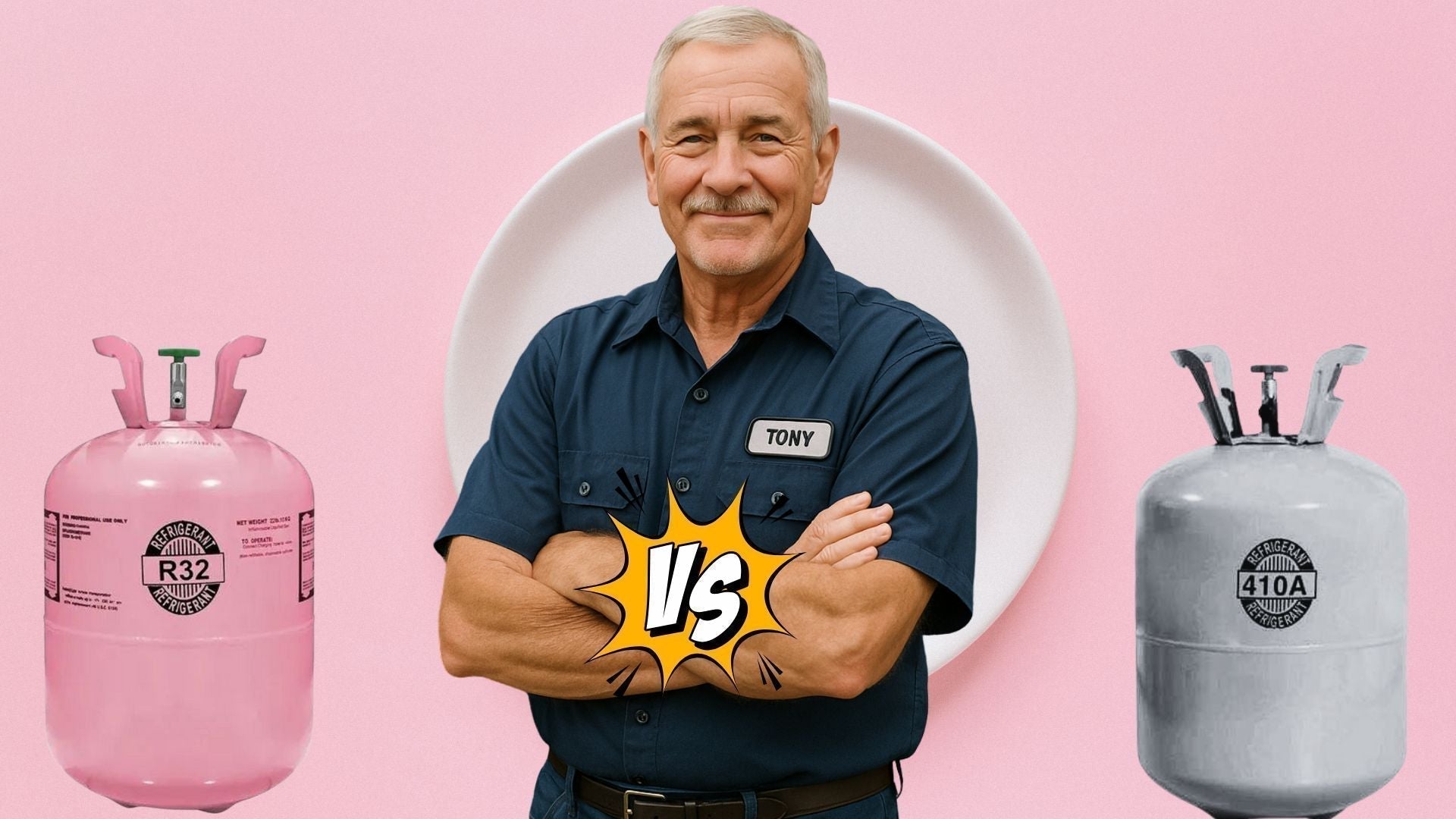(By Tony the Trusted Tech)
Look, I’ve been wrenching on AC systems since the R-22 days. I’ve seen refrigerants come and go—and I don’t usually get hyped about the latest industry trend. But this one? R-32 isn’t just a switch—it’s an upgrade. And if you're buying a new system in 2025, it’s time to pay attention.
Today, I’m laying out the real-world differences between R-32 vs R-410A, why the phase-down is happening, and what it means when you're picking out a system like this Goodman 3 Ton R-32 model.
Why HVAC Is Moving Away From R-410A
R-410A has been the standard for the last 20 years. It replaced R-22 because it had no ozone depletion potential. But now, the feds—and frankly, the rest of the planet—are looking at its Global Warming Potential (GWP).
R-410A has a GWP of 2,088, according to the EPA’s refrigerant factsheet. That means it's over 2,000 times more potent than CO₂ in trapping heat.
The U.S. is now phasing it down as part of the American Innovation and Manufacturing (AIM) Act, which aligns with the global Kigali Amendment. Bottom line? You won’t be able to install new R-410A systems for much longer. And service costs for existing ones? Already going up.
So What Makes R-32 Better?
Glad you asked. R-32 isn’t just a newer refrigerant—it’s a more efficient, more sustainable upgrade. Here's why I like it from a tech’s perspective:
1. Lower Global Warming Potential
R-32 has a GWP of 675, which is roughly 70% lower than R-410A. That means it's a much smaller contributor to climate change if it leaks.
As confirmed by ASHRAE, R-32 is considered one of the most promising lower-GWP refrigerants that still provides solid performance for residential HVAC.
2. Better Heat Transfer
R-32 absorbs and releases heat more efficiently. That means:
-
Smaller charge sizes (up to 30% less refrigerant needed)
-
Better system efficiency
-
Less compressor strain
In the field, I’ve noticed R-32 systems cool faster and cycle less often.
3. It’s a Single-Component Refrigerant
Unlike R-410A (a blend), R-32 is a pure refrigerant. That means:
-
Easier to reclaim and recycle
-
Fewer pressure balancing issues
-
More consistent performance in high-temp environments
That’s a win for service techs and homeowners alike.
What About Safety?
Now, let’s talk about the elephant in the room: R-32 is mildly flammable (A2L rated). But don’t let that scare you.
We're not talking about gasoline-level flammability here. R-32 needs the right air-to-gas mix and an open flame to ignite—just like natural gas. Manufacturers are already building systems with safeguards in place. In fact, countries like Japan and Australia have used R-32 safely for over a decade, with millions of installs under their belt.
As noted by UL Standards, updated codes and safety practices for A2L refrigerants are in full swing in the U.S., and every licensed tech is getting trained to handle it.
Comparing Performance in the Field
Here’s how R-32 and R-410A stack up in real-world installs:
| Feature | R-410A | R-32 |
|---|---|---|
| GWP | 2,088 | 675 |
| Efficiency | Good | Excellent |
| System Charge | Higher | Up to 30% lower |
| Component Simplicity | Blend | Single substance |
| Safety Rating | A1 (Non-flammable) | A2L (Mildly flammable) |
| Cost to Service | Increasing | Lower (for now) |
I’ve installed both. And in my experience? R-32 systems run cooler, cost less to charge, and are easier to service long-term.
What This Means for Buyers in 2025
If you’re buying a new system today, don’t get stuck with yesterday’s tech. R-410A is on its way out. That means:
-
Service costs will rise
-
Parts availability will drop
-
Resale and home inspection issues could come up
Going with R-32 now puts you ahead of the curve. And systems like this Goodman 3 Ton R-32 model? They’re built for what’s coming next.
Is R-454B a Better Alternative?
You might’ve heard about R-454B—another A2L refrigerant that some manufacturers are using. It’s a solid option too, with a GWP of around 466. But here’s the catch: R-454B is facing a refrigerant shortage in 2025 due to limited production and regulatory bottlenecks.
R-32, on the other hand, is already widely available and backed by heavyweights like Daikin, who are even helping other brands license it.
Tony’s Take: Why I Recommend R-32 Systems
“It’s not just about green labels or compliance. R-32 systems make my life easier in the field, and my customers see the benefits every month in their energy bills.”
Here’s when I recommend R-32 systems:
-
You’re buying a system you plan to keep 10–15 years
-
You want low maintenance and strong cooling performance
-
You care about long-term refrigerant availability and serviceability
-
You want to stay ahead of energy and environmental regulations
And when it comes to system pairing, a mid-efficiency SEER2 rating + R-32 refrigerant = best bang for your buck.
Final Word: Make the Smart Switch Now
R-32 isn’t a maybe—it’s where the industry is headed. It’s more efficient, more sustainable, and already well-supported. If you’re shopping around for a new system, go with one that’s built for tomorrow—not yesterday.
And for my money? Something like the Goodman 3 Ton 14.5 SEER2 R-32 setup hits the sweet spot between cost, cooling power, and future-proof performance.
Question to think: Is 14.5 SEER2 Enough for Your Home?







